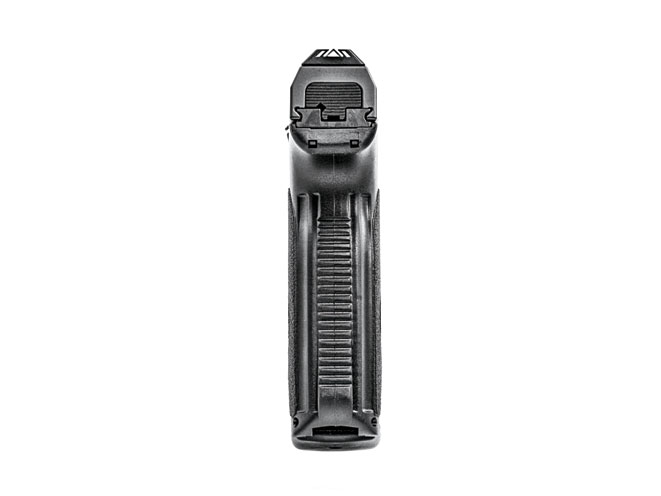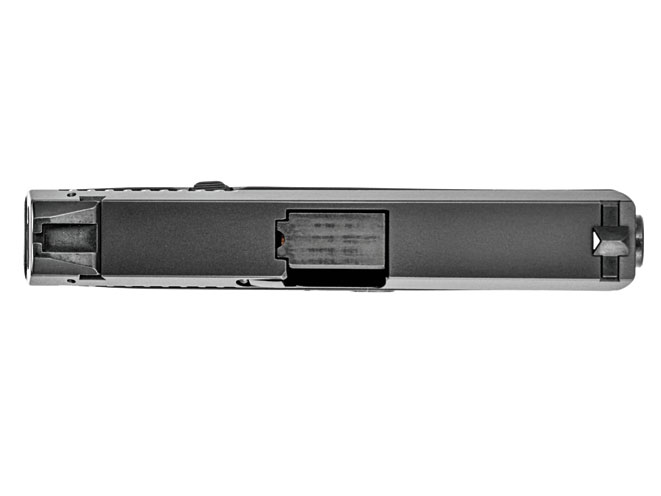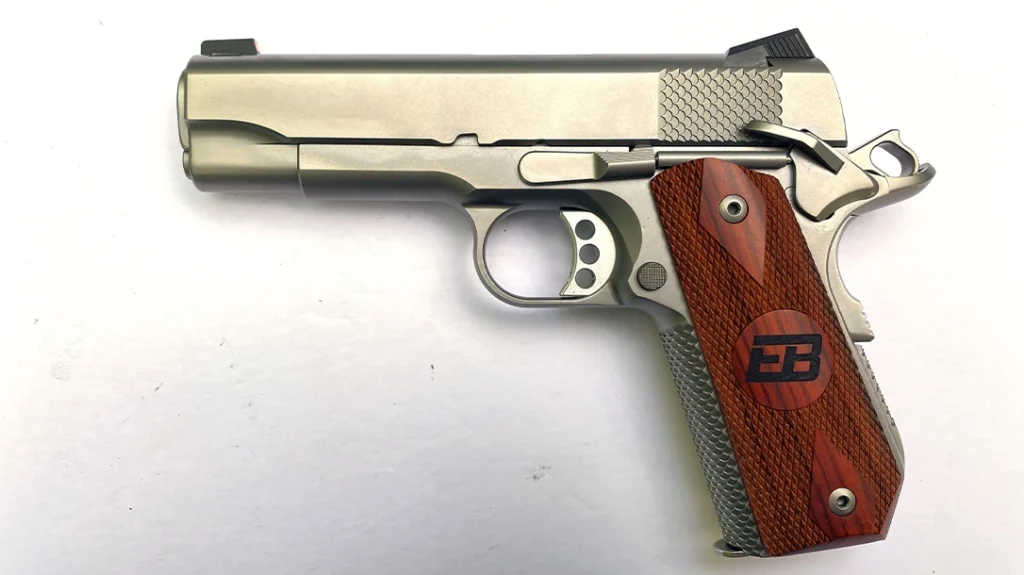Steyr-Mannlicher and Heckler & Koch have legendary reputations. Steyr began manufacturing pistols in 1912. HK was established in 1949, with its founders, Edmund Heckler and Theodor Koch, and chief designer Alex Seidel all having worked together at Mauser before starting out on their own. Along with Walther and Sig Sauer, Steyr and HK are among the greatest names in German firearms. Chosen to test the tale of the tape are the new Heckler & Koch VP40 and Steyr’s M40-A1.
Steyr M40-A1

The Steyr M40-A1 has many appealing features and a couple of unique Steyr designs. Unlike the VP40, the Steyr is not a new gun and has been in production for over 12 years. It was introduced in 2004 as an updated version of the “M” series, the company’s first polymer-framed, striker-fired pistol. The M40-A1 has a 12+1 capacity, giving up one round to the HK. The pistol’s trigger pull has a light, 6.5-pound average, with zero overtravel and very quick reset.
Advertisement — Continue Reading Below
With the Steyr using a pivoting blade trigger safety, it’s a coin toss between the two guns when it comes to trigger operation. Also, the Steyr’s mag release can be flipped to the right side for left-handed shooters. The M40-A1 is either elegant or ungainly (depending upon your point of view) with very trim operating controls and an unusual profile that increases in proportion from the breech to the muzzle. In other words, it is wider at the front than the back.
RELATED STORY: Looking For A Full-Size Concealed Carry Pistol? Try Steyr’s L40-A1
This is partially an optical illusion because of the triggerguard’s deep contour and a tapered frame that is slanting upward toward the hand-filling 111-degree-angled grips. The backstrap is also deeply contoured to place the back of the frame higher over the hand (like the VP40), thereby creating a low barrel axis to help reduce muzzle flip. Once you pick this gun up, wrap your hand around it and take aim down the unusual trapezoidal sights, you are apt to begin considering the M40-A1’s unique virtues.
Advertisement — Continue Reading Below
In size and weight, these two are equally matched. The HK is 7.34 inches in overall length, the Steyr 7.32 inches, but its barrel and slide are .09 inches shorter. In height the M40-A1 is 5.2 inches compared to the slightly taller 5.45 inch HK. The width of the VP40, with its rounded edges, is 1.32 inches compared to the blockier but narrower Steyr M40-A1 at 1.2 inches. The M40-A1 weighs 27.2 ounces, while the slightly larger HK is 28.8 ounces. (http://www.steyrarms.com; 205-417-8647)
HK VP40

Evolved from the successful HK P30, the polymer-framed VP9 and VP40 models have a unique legacy, the VP70 “Volkspistole” introduced back in 1970. Along with the later VP70Z variant, they were the world’s first striker-fired, polymer-framed semi-autos, preceding the Glock 17 by more than a decade. The double-action-only, blowback-action VP70 was built in both a military version, with selective three-round burst fire via a detachable shoulder stock apparatus, or as a civilian semi-auto version. The VP70 line was discontinued in August 1989, but, while never a high-production pistol, it laid the groundwork for the future of polymer-framed handguns.
Advertisement — Continue Reading Below
HK’s new VP9 and VP40 are derived from the current P30 design, including interchangeable backstraps and side grip panels. The VP models (and yes, VP still stands for Volkspistole or “people’s pistol”) offer fully ambidextrous operation of the slide and magazine releases, a Picatinny rail on the dust cover and can use all existing P30 steel magazines. One notable design improvement over the P30 is the VP’s deeply curved beavertail, which allows the slide to rest further back over the shooting hand. This improves recoil control and allows for a stronger grip.
RELATED STORY: Heckler & Koch’s Stylish, Street-Ready P30SK 9mm
The pistol also has slide releases on both the left- and right-hand sides. While ideal for left-handed operation (I tried it, and it works perfectly), the option of dropping the slide with the right-hand trigger finger is not practical. What is practical, however, is the ambidextrous magazine release built into the bottom rear of the triggerguard (like the Walther P99).
Advertisement — Continue Reading Below
What really sets the VP models apart from most striker-fired semi-autos is their excellent trigger pull and quick reset. The VP40’s average trigger pull is 5.4 pounds with only 0.24 inches of release to reset. Overall travel is just 0.5 inches. The rounded slide design has deep front and rear serrations to make handling easier, and the rear has one raised polymer lobe at the back of either side to provide an additional grasp when cambering the first round or clearing the gun.
Dovetailed, luminous, drift-adjustable front and rear combat sights are a standard feature on these guns, and the VP models also have a striker status indicator (a red dot on the back of the striker) exposed through an opening in the rear of the slide when the gun is ready to fire. With a 4.09-inch, cold-hammer-forged, polygonal-rifled barrel, rugged construction and an empty weight of 26.56 ounces, the 13+1 VP40 leaves little to be desired as a tactical sidearm. (http://www.hk-usa.com; 706-568-1906)
The Verdict
Advertisement — Continue Reading Below
In comparison, the Steyr has fewer features, no interchangeable backstrap panels, no striker status indicator, and the slide offers more resistance when chambering the first round. The HK’s big pluses are the ambi (Steyr’s is ambi, too) and easily accessed magazine releases and being able to tailor the grip configuration to the individual user’s preferences. The Steyr, however, is a very military-minded, one-size-fits-all design. Ounce for ounce, both of these duty-ready pistols measure up as excellent tactical sidearms.
RELATED STORY: Concealed Carry Comparison – Ruger LCP Custom vs. GLOCK 42
The range test was shot at 15 yards using Speer’s 180-grain GDHP ammunition. Velocity from both guns was almost identical with 963 fps average from the HK VP40 and 965 fps from the Steyr M40-A1. In use, the Steyr’s slide release is faster to operate than the HK’s (strong side), whereas the HK’s slide has less resistance when chambering the first round or clearing the gun. The sights on both guns are excellent, but the HK VP40’s luminous sights are much faster to acquire and hold on target.
Advertisement — Continue Reading Below
The .40 S&W is a heavy-recoiling round that produces more average muzzle rise than a .45 ACP in a handgun of similar size. Off-hand average groups were 1.5 to 1.75 inches for both guns. As tactical sidearms, the HK VP40, which retails for $719, comes out a slightly easier gun to handle over the less expensive $560 Steyr. Call it the triumph of the latest technology over slightly older technology.






























